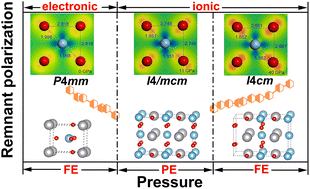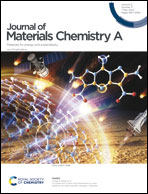Pressure-induced electronic to ionic phase transition and recurrence of ferroelectricity in PbTiO3†
Abstract
In the research reported in this paper, the evolution of electric, dielectric and ferroelectric properties of PbTiO3 under high pressures have been systematically studied by various methods, including in situ alternating current (AC) impedance spectroscopy and polarization–electrical field (P–E) hysteresis loop experimental measurements as well as molecular dynamics and charge density difference theoretical calculations. From the AC impedance spectroscopy measurement, an electronic-to-ionic transition was found at 7.0 GPa. The molecular dynamic calculations confirmed that the ionic conduction of PbTiO3 is attributed to the mobile O2− ions, and the charge density calculations revealed that the process of transition is related closely to the evolution of the delocalization state of the Ti4+ ions under high pressures. The pressure dependence of the dielectric loss factor was also obtained from the AC impedance spectroscopy measurement. In the electronic conducting phase, the grain and grain boundary have quite different effects on dielectric loss, but in the ionic conducting phase, they have similar effects. For the P–E hysteresis loop measurements, a recurrence of the ferroelectricity was found in PbTiO3 under high pressures, which has relationships with the pressure-induced structural phase transitions.



 Please wait while we load your content...
Please wait while we load your content...